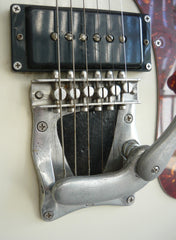Tym aluminium neck prototype
Share
I've been cleaning up this monumental mess that is my workshop recently and I've been coming across "long lost" stuff that I thought I'd lost, or forgotten I had/made so I'll do a few posts to show you guys the most interesting (I think?) stuff.

This has been hanging on my wall in the back room for years and was covered in dust and ........ what looked like mud. I'm not even going to contemplate what it was. I got it off the wall and cleaned it up a little for the pics and started playing it and it bought memories flooding back. When I started making guitars I actually dreamed of making aluminium neck guitars as I'd always been a big fan of Travis Bean and Wandre, and have been lucky enough to own both (still own a TB) along with a bunch of other metal neck guitars over the years since.

I came up with the idea of casting a neck after I got a local foundry to cast vibrato pieces that I'd carved from molds of Mosrite units. I got talking to them one day and mentioned how I'd love to make a guitar neck. "Just make a pattern and I'll cast it" they said.
I made a pattern out of pine and gave it to them. A few weeks later they rang and said "I hope you've got a crane to pick this up" ..........
I couldn't believe how heavy it was ? Aluminium is light, isn't it ? Apparently not.
I finished it off with a jarrah fretboard and fitted it to a body I quickly made for the experiment. It played really well but was way too heavy to be used properly. I removed the neck and drilled holes into the back of the headstock to try and lighten it to make it usable. Still no good.

This neck is SOLID aluminium. I realized that with the strength of metal I didn't actually need it solid. I could hollow it out all the way down the neck and still have plenty of strength. I also hollowed out the headstock TB style although keeping the angled end of the headstock like a Ric/Mosrite making the T angled also. I actually loved the look of this T cutout and kept it through two more progressive patterns I kept working on to make it lighter.
The second pattern has a headstock with the T cutout but full thickness the whole way through. The third pattern has a hollowed out part in the back of the headstock to make it even lighter. The last pattern I worked on was actually lighter than the timber necks I was making and looked like they were going to work REALLY well in terms of being usable on my, and aftermarket guitar bodies.
I still have the patterns here so these can be made again down the track if I ever have time to start this project back up again. I did make a final pattern that was mad to retro fit any long scale (25.5") Fender body as a direct replacement making it usable on Strats, Teles, Jazzmasters etc.

This guitar was obviously based on my Wosrite guitars I was making at the time which were Mosrite Ventures copies. I was making the vibratos at the same foundry, cleaning them up and drilling and assembling them in the workshop. I made the bridges myself from stainless steel box section cut in half and stainless steel rod cut and "notched" to use as saddles. This all took a LONG time to make by hand but was the only way I could get my guitars to look like Mosrites as they made most of their own hardware in house and no aftermarket parts were available back then.
This guitar was before I started making actual Mosrite pick ups so I used P-90's and made surrounds to look like Mosrite pick ups. I'm a huge fan of P-90's so I was pretty happy to use them and they are pretty close to Mosrite single coils anyway.
Even though this guitar could be considered a failure of sorts it was my first attempt to make an aluminium neck and did work from a playing point of view. It played well and intonated properly but was simply just too heavy to be practical. It was successful in that it led to further ideas and patterns that did work VERY well.
Here's a link to later aluminium necks I made that worked well and took me further in alternative materials.




